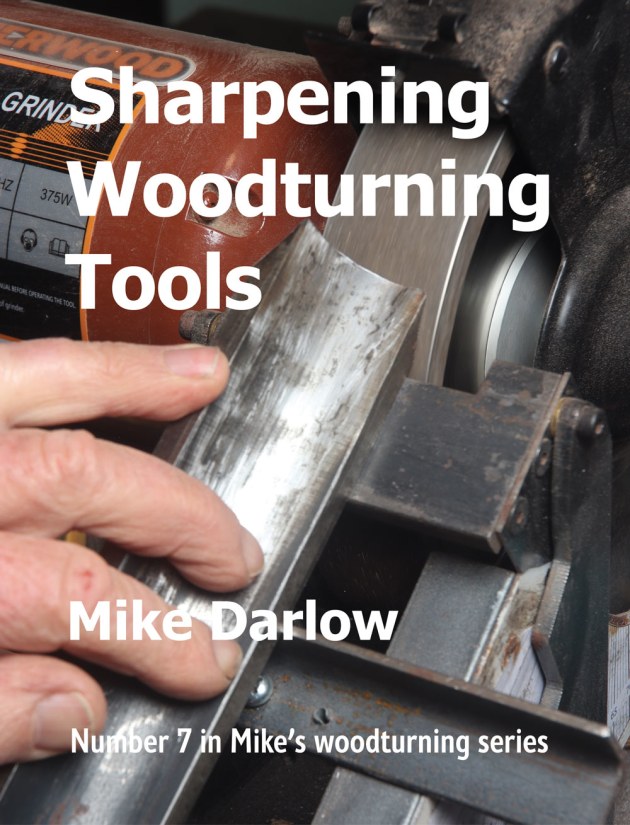Mike Darlow: New book on sharpening released
In the woodturning related sphere, Mike Darlow is a prolific author with numerous articles and now an eighth self-published book. In Sharpening Woodturning Tools, Mike tackles the critical topic of sharpening, and after reviewing a good deal of past published literature, concludes that much of the advice given was ‘suboptimal’.
Mike Darlow explains…
My eighth woodturning book shows that you can with the appropriate knowledge and modest equipment sharpen quickly and accurately, and will need to do so less often.
Unlike almost all other how-to woodturning books Sharpening Woodturning Tools doesn’t just describe the techniques the author uses, and suggest you should too. Instead in it I analyse the sharpening information published in England, USA and Germany in 33 woodturning books since 1881, and find much of it suboptimal. Then by applying the principles (fundamental truths) of woodturning and woodturning sharpening I’m able to establish both the optimum tool nose geometries, and the most efficient ways to achieve them.
In the woodturning books published prior to WWII carbon-tool steel turning tools, excluding scrapers, were sharpened to between 20° and 30°. Shortly after WWII the commonly recommended sharpening angles suddenly increased by 15° to 20°. Rarely was a reason given, and when it was it was to supposedly increase cutting edge longevity. This increase in recommended sharpening angles has been maintained until today, even though HSS woodturning tools have been the norm since the 1970s, only 60 years after HSS tool bits had been introduced into metal machining.

Figure 1: Showing that providing the edge doesn’t crumble, the smaller the sharpening angle, the greater the abrasion needed to bring the edge to a given bluntness, and therefore the longer the duration between resharpenings.
Leonard Lee’s impressive book The Complete Guide to Sharpening states: “A chisel should always be sharpened at the lowest bevel angle consistent with edge retention”. Later research on plane blades by Steve Elliott explains that this is because as the sharpening angle is reduced, more abrasion is needed to blunten the edge as figure 1 illustrates. Also the intervals between resharpenings can then be increased. Hence the proper criterion for sharpening cutting edges is that an edge’s sharpening angle should be just large enough so that the edge just doesn’t crumble in use.
What was the reason for the dramatic increase in sharpening angles and the proliferation of sometimes vague and/or contradictory advice? I can only assume it has been because the principles of woodturning have been poorly understood. SWT’s chapter 2 therefore explains these principles which for cutting are:
• The edge should be ground and honed to an appropriately small sharpening angle
• The edge should be presented and traversed with minimum clearance and with side rake (i.e. be well skewed to the velocity of the oncoming wood)
• The tool should have an appropriately large flute radius for finishing cuts, the edge should be traversed slowly, and take a thin shaving which isn’t strong enough to tear out wood from below the intended cut surface
In chapter 3 I discuss and analyse sharpening materials and equipment. I favour the recently-introduced CBN (cubic boron nitride)-plated grinding wheels, but recognise that for the occasional sharpener aluminium oxide wheels are a cheaper and satisfactory alternative. I also find that some equipment is misconceived, and conclude that spending more does not always benefit.
Chapter 4 covers the sharpening of the various tool types. It explains why some forms of blade and tool nose are optimum, and some aren’t.

Figure 2: Darlow template, here for a scraper with a bevel angle of 70°, being used to set a platform jig. On the left-hand side of the template are two projecting pins. These are held against the grinding wheel’s periphery while the platform is locked in position while its top surface is held up against the template’s reference edge.
My 2001 book Woodturning Techniques introduced Darlow Templates—one is shown in use in figure 2. These enable the platform of a platform grinding jig to be repeatedly set to the correct angle even as the grinding wheel’s diameter reduces. If you’re using the smaller sharpening angles I advocate, as figure 3 demonstrates it’s important to minimise, or better eliminate, grinding error. A full range of the designs for Darlow templates is included in SWT.
Chapter 4 also includes 12 pages on bowl gouges. It promotes outboard bowl turning (on the left-hand end of the headstock spindle), a practice which was strongly promoted until 50 years ago. It also promotes convex bevels on bowl gouges, a feature which I invented and first promoted in 1998.
In the last chapter, chapter 5, I regret the repression of debate and analysis in some of the woodturning media. While most turners don’t feel the need to turn as well as they possibly could, this repression lessens their ability to make informed choices, and encourages the proliferation of suboptimal advice.
Sharpening Woodturning Tools has a soft cover, 115 pages, is sized 216 x 280mm, a five page index, and 242 colour illustrations. The book is available from Amazon Australia.



